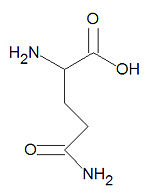Glutamine: Difference between revisions
Jump to navigation
Jump to search

imported>David E. Volk (stub and structure) |
imported>David E. Volk mNo edit summary |
||
| Line 1: | Line 1: | ||
{{subpages}} | {{subpages}} | ||
[[Image:Glutamine stick figure.jpg|right|thumb|150px|{{#ifexist:Template:Glutamine stick figure.jpg/credit|{{Glutamine stick figure.jpg/credit}}<br/>|}}Glutamine, a common amino acid.]] | [[Image:Glutamine stick figure.jpg|right|thumb|150px|{{#ifexist:Template:Glutamine stick figure.jpg/credit|{{Glutamine stick figure.jpg/credit}}<br/>|}}'''Glutamine''', a common amino acid.]] | ||
'''Glutamine''', abbreviated '''Gln''' or '''Q''', is one of the twenty common <math>\alpha</math>-[[amino acid]]s used by living organisms to build [[protein]]s. It is closely related to the acidic amino acid [[glutamic acid]] which has a [[carboxylic acid]] in place of the amide group present in glutamine. Glutamine is a neutral but polar amino acid. [[Asparagine]] has a similar structure with a side chain that is one carbon atom shorter. | '''Glutamine''', abbreviated '''Gln''' or '''Q''', is one of the twenty common <math>\alpha</math>-[[amino acid]]s used by living organisms to build [[protein]]s. It is closely related to the acidic amino acid [[glutamic acid]] which has a [[carboxylic acid]] in place of the amide group present in glutamine. Glutamine is a neutral but polar amino acid. [[Asparagine]] has a similar structure with a side chain that is one carbon atom shorter. | ||
Revision as of 17:56, 17 January 2008
Glutamine, abbreviated Gln or Q, is one of the twenty common -amino acids used by living organisms to build proteins. It is closely related to the acidic amino acid glutamic acid which has a carboxylic acid in place of the amide group present in glutamine. Glutamine is a neutral but polar amino acid. Asparagine has a similar structure with a side chain that is one carbon atom shorter.

